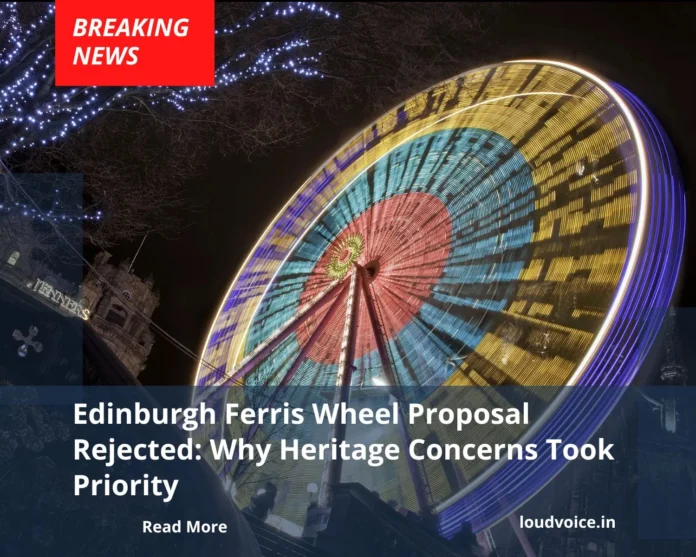Edinburgh Ferris Wheel Proposal Rejected: Council Blocks Over Heritage Concerns
Edinburgh Council has officially rejected a proposal to install a 45-meter Ferris wheel in Princes Street Gardens for the summer season, citing concerns over heritage conservation and public space management. The decision comes after widespread opposition from heritage groups, local residents, and city officials who raised concerns about the impact of such a structure on Edinburgh’s historic skyline and public spaces.
The proposal, submitted by events company Unique Assembly, aimed to erect the structure in mid-June, with operations running from July 1 to early January—pausing briefly in November for Remembrance Day events. While the company suggested that the Big Wheel would be a “welcome return to the summer skyline,” the plan met with strong resistance.
Opposition from Heritage Groups and Residents
The rejection follows extensive feedback from community councils, local organizations, and heritage groups, all of whom voiced their concerns about the potential disruption to Edinburgh’s landscape.
Edinburgh World Heritage strongly opposed the plan, arguing that an extended summer operation would be “a step too far” in commercializing the historic public space. The organization warned that approving such a project could set a precedent for similar proposals in the future, threatening the city’s unique charm and aesthetic integrity.
The group emphasized that Edinburgh already boasts several panoramic viewpoints, including Calton Hill, the Mound, and various historic buildings on Princes Street, which offer breathtaking views without altering the skyline. They also pointed out that the Big Wheel would obstruct key sightlines, affecting the city’s renowned architectural harmony.
Simon Holledge, representing the New Town and Broughton Community Council, echoed these concerns, stating that keeping the attraction in place for such an extended period could cause “reputational damage” to Edinburgh. He criticized the placement of the semi-lit wheel near the Walter Scott Monument, calling it an “uncomfortable juxtaposition” and warning that it could diminish the historical and cultural significance of the area.
Further concerns were raised about the environmental impact of the attraction. Residents and conservationists pointed out that increased foot traffic and infrastructure requirements could strain Princes Street Gardens, a cherished green space within the city. Noise pollution, additional lighting, and the potential for damage to park grounds were also cited as significant drawbacks.

Council’s Final Decision
Councillor Val Walker, Edinburgh’s Culture and Communities Convener, reaffirmed the city’s commitment to maintaining a balance between tourism and local interests.
“Edinburgh is a world-class visitor destination, and we boast an increasingly attractive events calendar – but this must be balanced with the needs of our residents and our duty to protect our beautiful parks and greenspaces,” she stated.
With these considerations in mind, and after reviewing stakeholder feedback, the council decided that the application should not proceed. Walker further stressed that while the city welcomes innovative ideas to enhance visitor experiences, proposals must align with Edinburgh’s historic and cultural values.
The Future of Public Space Management in Edinburgh
This decision highlights the ongoing debate over how public spaces should be used in Edinburgh, particularly in a city that relies heavily on tourism. While events and attractions contribute to the local economy, officials and heritage groups continue to advocate for preserving Edinburgh’s historical identity and ensuring residents’ quality of life is not compromised.
Local businesses and tourism operators, however, have expressed concerns that such rejections might limit Edinburgh’s ability to modernize its entertainment offerings. Some believe that with careful planning and proper regulations, temporary attractions could coexist with the city’s heritage sites without causing disruption.
Moving forward, city planners and stakeholders will need to consider alternative ways to enhance the visitor experience while respecting Edinburgh’s rich history. Proposals that involve low-impact, heritage-sensitive attractions or seasonal pop-ups may find greater support from conservationists and the public alike.
The council’s rejection of the summer Ferris wheel serves as a reminder that all future proposals must carefully balance commercial interests with cultural and historical preservation. The debate over public space management in Edinburgh is likely to continue as the city strives to find the right balance between economic growth and heritage conservation.


